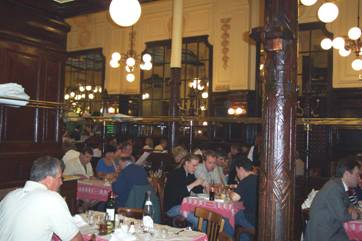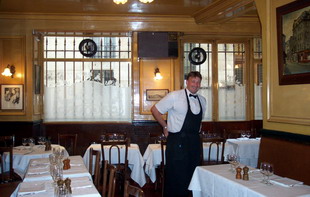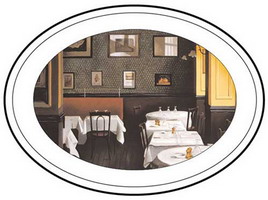Eating history
Chartier and Allard
 Chartier and Allard are two famous Paris eating places which have survived for over a century serving much the same food throughout most of their history. Chartier is a no-frills ancestor of the fast food restaurant – fast in turnover though not necessarily in preparation or cooking time – whose splendid old panel-and-mirror interior seems remarkably grand for the working class clientele who were once its principal customers. Today it is a must-see Mecca for tourists which nevertheless continues to serve up culinary classics at rock-bottom prices to locals who lunch there every day because it’s about as cheap as a civilized sit-down establishment can be. Chartier keeps costs down by sticking to its long-established repertoire and refusing credit cards, which would skim the cream off its modest mark-ups.
Chartier and Allard are two famous Paris eating places which have survived for over a century serving much the same food throughout most of their history. Chartier is a no-frills ancestor of the fast food restaurant – fast in turnover though not necessarily in preparation or cooking time – whose splendid old panel-and-mirror interior seems remarkably grand for the working class clientele who were once its principal customers. Today it is a must-see Mecca for tourists which nevertheless continues to serve up culinary classics at rock-bottom prices to locals who lunch there every day because it’s about as cheap as a civilized sit-down establishment can be. Chartier keeps costs down by sticking to its long-established repertoire and refusing credit cards, which would skim the cream off its modest mark-ups.
For this Paris trip Mary and I made Chartier our first lunch stop. We were immediately struck by its pleasantly efficient bustle. Having been asked whether we preferred smoking or non-smoking – the first time ever in a French restaurant! – we were shown to an empty table for four, where our effort to sit together on one side was pleasantly but firmly corrected. The house procedure was that we should sit opposite each other on the seats next to the wall, so that a later-arriving couple could easily join us. They had probably established decades ago that this was the most efficient seating arrangement; who were we to question it?
The slate at the front door proved to be for show; we were given printed menus from which to make our selection. It would be pleasing to report that we ate well for little, but sadly we got approximately what we paid for. Mary’s vegetable soup for just over a euro was thin and watery, green from some unknown vegetable which imparted color but no flavor. My duck-and-orange pâté tasted of neither duck nor orange, a crude but bland product that would not do credit to a supermarket. Mary’s roast chicken had been cooked through but kept too long, so that it had dried out and begun to harden – freshly rotisseried chicken from almost any Paris stall would have been tastier and juicier. My rabbit came with a pleasant cream sauce but would have benefited from enough cooking to allow the meat to be removed from the bone without a struggle. The noodles tossed in butter which accompanied it were the most satisfying item on our collective plates.
No doubt those who eat regularly at Chartier will have discovered a selection of dishes that satisfy them, but casual customers may well find themselves dining unhappily on pig-in-a-poke. But go by all means, if only for the ambiance and for the waiters, who are traditionally dressed, highly skilled and decently polite. You will have experienced a slice of Paris history for little more than the cost of an instant cliché from a sidewalk vendor, and it’s less likely to poison you. In fact you may even strike it lucky – and the dirt-cheap wines by the pichet are better than they have any right to be.
-0-
NOTE: Last year [2013] Alain Ducasse added Allard to his stable. This year it is Pudlo Paris' bistro of the year. I sincerely hope that this is not hype and that the following sad review is now itself history.
 Allard has a history of culinary excellence which takes it well beyond the merely picturesque. Its soberly panelled dining rooms will undoubtedly have witnessed the consumption of enough Bresse chickens to stock an infinity of high class butchers. The Guide Gastronomique de Paris 1953 described Chez Allard as Très grande cuisine dans un décor simple. The same year James Beard’s Paris Cuisine noted its “simplicity and quality” and identifies it as “a bistro of the rather expensive category."
Allard has a history of culinary excellence which takes it well beyond the merely picturesque. Its soberly panelled dining rooms will undoubtedly have witnessed the consumption of enough Bresse chickens to stock an infinity of high class butchers. The Guide Gastronomique de Paris 1953 described Chez Allard as Très grande cuisine dans un décor simple. The same year James Beard’s Paris Cuisine noted its “simplicity and quality” and identifies it as “a bistro of the rather expensive category."
Allard settled into more or less its present culinary format around 1935 when the new owners gave it its eponymous name. The chef was Mère Allard; according to John and Karen Hess, she was “one of the great woman cooks of France”. By this they meant women restaurant cooks, not a common thing at that time except in Lyon, where socio-economic factors produced the buchons, often run by the wives of the working men who frequented them for lunch. Mère Allard became famous for her beurre blanc, the wonderful butter sauce invented by the women of the Loire that gives a plain poached fish everything it needs. (The Hesses include Mère Allard’s definitive recipe in their indispensible diatribe, The Taste of America, p195.)
Though Chez Allard was sold again half a century later in 1985, the next owner kept the name and the format, and so it retained its long-held reputation for generous portions of classic bourgeois recipes served up to rich foreigners who temporarily forsook their luxury hotels on the right bank to enjoy “slumming it” at a left bank bistro. Today it is neither so faux-naïf nor so astronomically expensive as l’Ami Louis, that fashionably Bohemian bistro which confronts its rich celebrity punters with portions so gargantuan that even Orson Welles or Marlon Brando might have left them unfinished. As a result, Allard is now likely to be the preferred choice of modestly well-off couples who want to eat their way through a whole Bresse chicken and a mountain of girolles without taking out a second mortgage.
 Knowing its popularity, we made this the one restaurant we bothered to book well in advance. Upon arrival at opening time we could see that the management had conscientiously made every effort to accommodate the maximum of covers. The small square tables along the banquette had no gaps whatsoever between them. The corner table reserved for us was so tightly jammed between its neighbors that it had to be pulled well out before we could be seated: woe betide the diner with a weak bladder. (The old photo on the right shows that our table in the corner was once round and had rather more elbow room.)
Knowing its popularity, we made this the one restaurant we bothered to book well in advance. Upon arrival at opening time we could see that the management had conscientiously made every effort to accommodate the maximum of covers. The small square tables along the banquette had no gaps whatsoever between them. The corner table reserved for us was so tightly jammed between its neighbors that it had to be pulled well out before we could be seated: woe betide the diner with a weak bladder. (The old photo on the right shows that our table in the corner was once round and had rather more elbow room.) Ignoring the formidable prices, I ordered what I had already chosen: escargots de Bourgogne and poulet de Bresse (2 pers) aux girolles sautées. For her starter, Mary opted for the terrine de canard. To accompany this Circean pig-out I opted for a Pouilly fumé 02, at 33€ one of the cheapest wines on the list.
As we waited for our entrées, the restaurant was already filling up with casually but expensively dressed Anglophones. The conversations, mostly in penetrating American accents, included basic culinary questions which suggested that many of the diners were unfamiliar, not only with Allard, but indeed with la cuisine française. The waiters’ haughty disdain was perhaps a conditioned reflex born of long experience.
Our starters arrived. The escargots were excellent (at 18€ they certainly should have been) but they were no better than I’ve had all over France at half the price. It’s a simple dish which need only be removed from the oven before the snails get tough; with a decent supplier, a generous dollop of butter, a handful of herbs and abundant garlic, its improper preparation would require a positive effort. As for Mary’s pâté, it was more or less like what we routinely make at home, following a straightforward Cordon Bleu recipe. The ingredients that fill our large terrine come to about £8, the cost of Mary’s single slice.
By now the chair just next to Mary’s – virtually as close as an adjoining seat in Eurostar’s Economy Class – was occupied by an expensively dressed women who immediately took out a packet of cigarettes. Mary very politely explained that she had a serious problem with cigarette smoke. The woman’s equally polite but firm suggestion was, take the matter up with the management; she would refrain from smoking while we were eating, she conceded, but no longer.
Our chicken arrived just under an hour after we had ordered it, as well it should at the very least. It was roughly hacked up and swimming in its own juice, a sign that it would have benefited from a rest before carving to allow the precious fluid just under the skin to be partially reabsorbed. Its clear color assured us that the bird was cooked to the point of safety, but only just: my attempts to separate the leg meat from the bone were as strongly resisted as if the unhappy fowl were fighting for its life. The parson’s nose, one of my favorite delicacies, refused to come away from the spine; its firmness revealed that its fat was still so solid as to comprise an unpleasant mouthful.
On the platter next to the bird was a mountain of sautéed girolles. Mary found them so sandy as to make her grit her teeth, both figuratively and literally. I didn’t notice, possibly because I have always eaten my peck of dirt with a certain fatalism.
The flavor of our Bresse chicken, France’s most famous, was as good as that of an anonymous organic bird from Waitrose – no better, no worse. (It was certainly not as complex as the fine specimens from Sheepdrove.) The rich crispy skin was delicious, but its flavor had not penetrated below the surface; even the breast had not been cooked to the point of succulence and the expelling of juices released by its premature carving had left it somewhat dry, resistant to both fork and tooth. Compared with any of our home-cooked birds – enclosed in a chicken brick and slow-braised for a couple of hours in their own juices, then allowed to rest for at least twenty minutes before carving – this excellent fowl had suffered a sadly wasted and unfulfilling death.
Nevertheless, at 66€ it merited a struggle. We carved our way through all but the back, whose meat I tried unsuccessfully to remove with the dull knife thoughtfully provided. (Tearing it away with our teeth seemed inappropropriately barbarous.) I was about to make another attempt when our waiter suddenly whisked the platter away together with the last few spoonfuls of precious jus. That was it! The sooner we were out, the better. We could stop at a café for dessert and coffee, and the fag-deprived lady at the adjoining table could then puff away to her heart’s content. We signalled for l’addition, which our waiter brought with a sullen scowl. Our prematurely terminated dinner came to 119€, as large a bill as for any meal of our trip. We found our own coats on the way out, with no help offered by the staff and no smiling farewell at the door. My only pleasure has been to imagine their reaction when they read this review, which, if you Google Allard Paris, comes up near the top of the first page.
Perhaps if I'd phoned up and said, "I'm Jesus Christ and I'd like a table for thirteen," we would have had a transubstantiate experience.
Chartier, 7 rue du Faubourg-Montmarte, 9th Tel 01 47 70 86 29, Mº Grands Boulevards
Allard, 41 rue St-André-des-Arts, 6th Tel 01 43 26 48 23, Mº OdéonMay 2006 Reinforcement comes from the redoubtable François Simon of Figaro in a Departure interview: Of the many places Simon feels you can do without, two classics are worth mentioning: ...the Saint Germain bistro Allard, where he says the chicken is lousy and cut à la "chain-saw massacre".
October 2007 A distinguished author with a discriminating palate writes to me: I and a friend had the chicken. It was exactly as you describe. A disgrace; I wish I'd had the courage to send it back. I shall never go there again.
Back to the beginning of this review
